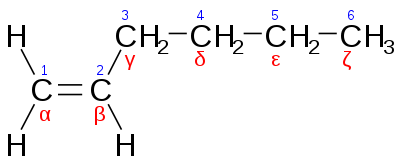Alpha-olefin
Alpha-olefins (or α-olefins) are a family of organic compounds which are alkenes (also known as olefins) with a chemical formula CxH2x, distinguished by having a double bond at the primary or alpha (α) position.[1] This location of a double bond enhances the reactivity of the compound and makes it useful for a number of applications.

The blue numbers show the IUPAC numbering of the atoms in the backbone chain of the molecule. The red symbols show the common nomenclature labeling of the main chain atoms. The double bond of an alpha olefin is between the #1 and #2 (IUPAC) or α and β (common) carbon atoms.
Classification
There are two types of alpha-olefins, branched and linear (or normal). The chemical properties of branched alpha-olefins with a branch at either the second (vinylidene) or the third carbon number are significantly different from the properties of linear alpha-olefins and those with branches on the fourth carbon number and further from the start of the chain.
Examples
Examples of linear alpha-olefins are propene, 1-butene and 1-decene.
An example of a branched alpha-olefin is isobutylene.
See also
References
- Petrochemicals in Nontechnical Language, 3rd Edition, Donald L. Burdick and William L. Leffler, ISBN 978-0-87814-798-4